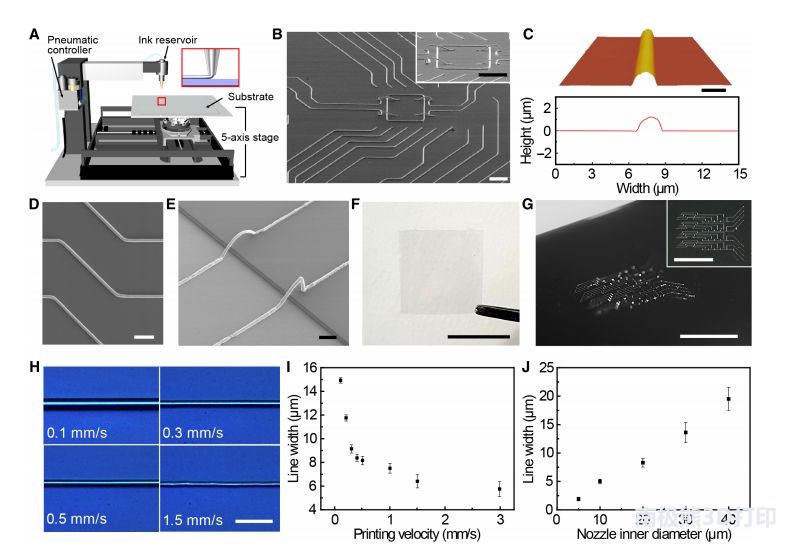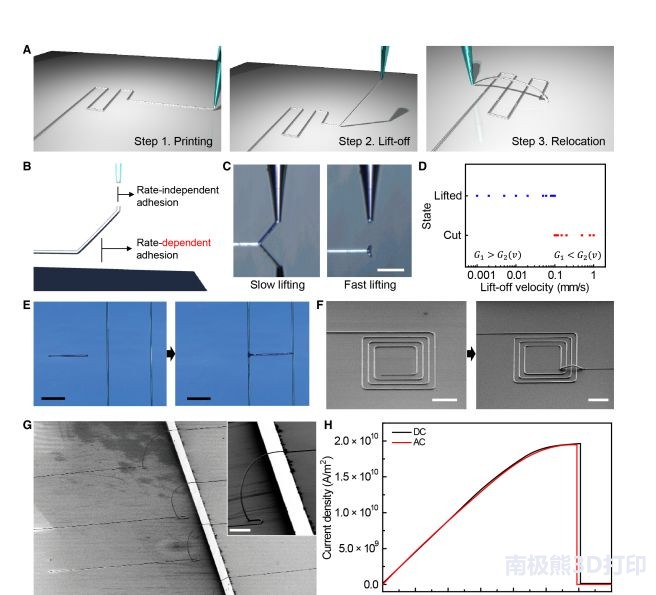In the article “High-resolution, three-dimensional structure of liquid metal reconfigurable printing”, the authors explored metal3D printingNew technology outside the field.Through liquid metal3D printing, The authors can create “scalable” 3D integration to form a “diversified 3D structure”. As an example of this research, they created a reconfigurable antenna.

Figure 1: High-resolution printing of liquid metal. (A) Schematic diagram of the printing system. (B) Scanning electron microscope images of 2D and 3D high-resolution EGaIn patterns. Scale bar, 100 mm. Inset: SEM image of magnified 3D structure. Scale bar, 100 mm. (C) Print the AFM image and cross-sectional profile of the EGaIn line. Scale bar, 2 mm. (D) Scanning electron microscope image of a 1.9 mm wide EGaIn pattern. Scale bar, 10 mm. (E) Scanning electron microscope image of 3D pattern of EGaIn on PET film and epoxy resin (SU-8). Scale bar, 10 mm. (F) A photo of the high-resolution EGaIn pattern printed in (B). Scale bar, 1 cm. (G) Photograph of the interconnection pattern of EGaIn. Illustration: Top view photo. Scale bar, 5 mm. (H) Optical micrograph of EGaIn line printed according to printing speed. Scale bar, 40 mm. (I) The graph of the relationship between line width and printing speed. (J) The relationship between line width and nozzle inner diameter. The error bars in (I) and (J) indicate SD.
The deformity in the device is the focus of attention here, focusing on applications in “free electrons”, such as:
• Stretchable electronic products
•Wearable electronic products
•Soft actuator
•robot
Previously, there were challenges in finding suitable materials for these devices, which required movable parts that were also suitable for consumers or were easy to operate as functional objects. The author points out that brittleness is usually a problem, although conductive materials have been developed, such as corrugated metals, metal networks, and various composite materials.Although promising, this approach is not always scalable to3D printing, And resolution may be an issue.
“Although filament-based direct ink writing methods using metal nanoparticle (such as Ag or Cu) inks have shown some feasibility for high-resolution printing, they require additional thermal annealing or drying processes to form conductive paths. It can cause softening and damage to a tissue-like matrix. In addition, these printed and thermally annealed metal patterns are relatively rigid and hard. Therefore, repeated device deformation can cause these metal electrodes to crack or fail.”
The researchers discussed liquid metals, such as eutectic gallium indium alloy (EGaIn) and gallium indium tin alloy (Galinstan), both of which have low toxicity and extremely low volatility. Compared with solid metals, they also exhibit excellent electrical conductivity. Although microfluidics or photolithography can be used to pattern liquid metals, their structure is limited to the 2D domain. Using fine nozzles to print liquid metal under environmental conditions, the author was able to create high-resolution structures. The use of narrow wires allows independent structures to be made of liquid metal; in fact, they can even be lifted and moved by the nozzle.

Figure 2: Reconfiguration of liquid metal into a three-dimensional structure. (A) Schematic diagram of each reconfiguration step. (B) Schematic diagram of two adhesion forces during reconfiguration. (C) Photograph of Egain peeled off (left) and cut (right) from the substrate. Scale bar, 100 mm. (D) The relationship diagram between pipeline state and nozzle lifting speed. (E) Optical micrograph of reconfiguration. The printed horizontal line (left) is lifted and reconfigured (right). Scale bar, 200 mm. (F) Scanning electron microscope image of the reconfigured square coil. The inner end of the square coil (left) is lifted and reconfigured (right). Scale bar, 200 mm. (G) Scanning electron microscope image of Egain 3D bridge. Scale bar, 500 mm. Inset: Magnified scanning electron microscope image of a three-dimensional bridge. Scale bar, 200 mm. (H) Curve graph of applied deviation and response current density in EGaIn.
Using the nozzle installed on the syringe and the substrate placed on the five-axis platform, the high-resolution antenna3D printingAs a research sample. The team also created an independent electrode structure that minimizes interconnections and “aims to achieve a higher level of integration of miniaturized devices.”
“We believe that this high-resolution 3D reconfiguration method provides a promising strategy as an additive process that can be combined with traditional manufacturing techniques of highly integrated and stretchable devices, which demonstrates that in the next generation of electronics There are great application prospects in the equipment.” The researcher said.
Although many industrial users are enjoying advantages such as being able to construct strong and lightweight complex geometries, they are exploring the role of metal as3D printingThe strongest medium, whether it is manufacturing porous metal biomaterials, automated metal plate production, or patented metals with high carbide content.

Figure 3: Direct printed and reconfigured electrical contacts of liquid metal. (A) Schematic diagram of direct printing (left) and reconfiguration (right). (B) Dependence of total resistance on channel length. Error bars represent SD. (C) Current-voltage characteristics between Ag pad and direct printing EGaIn. (D) Current-voltage characteristics between the Ag pad and the reconfigured EGaIn. (E and F) Scanning electron microscope image of EGaIn on the Ag pad after 7 hours of direct printing. (G and H) Scanning electron microscope image of EGaIn 7 hours after reconfiguration. Scale bar, 200 mm.
(Editor in charge: admin)


0 Comments for “South Korean researchers use liquid metal for 3D printing”